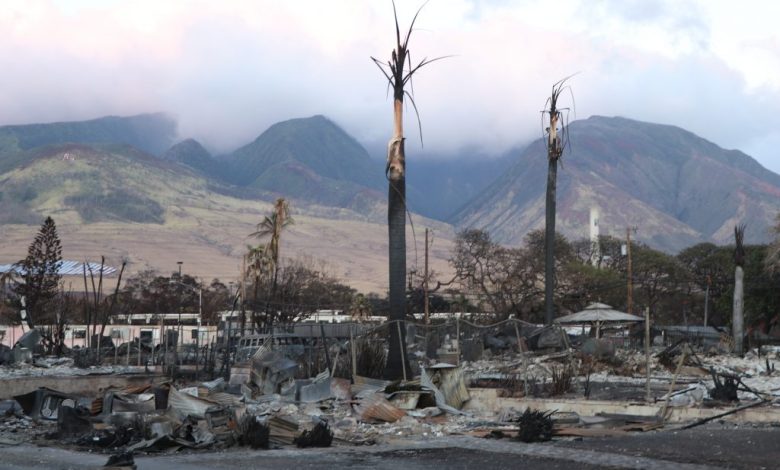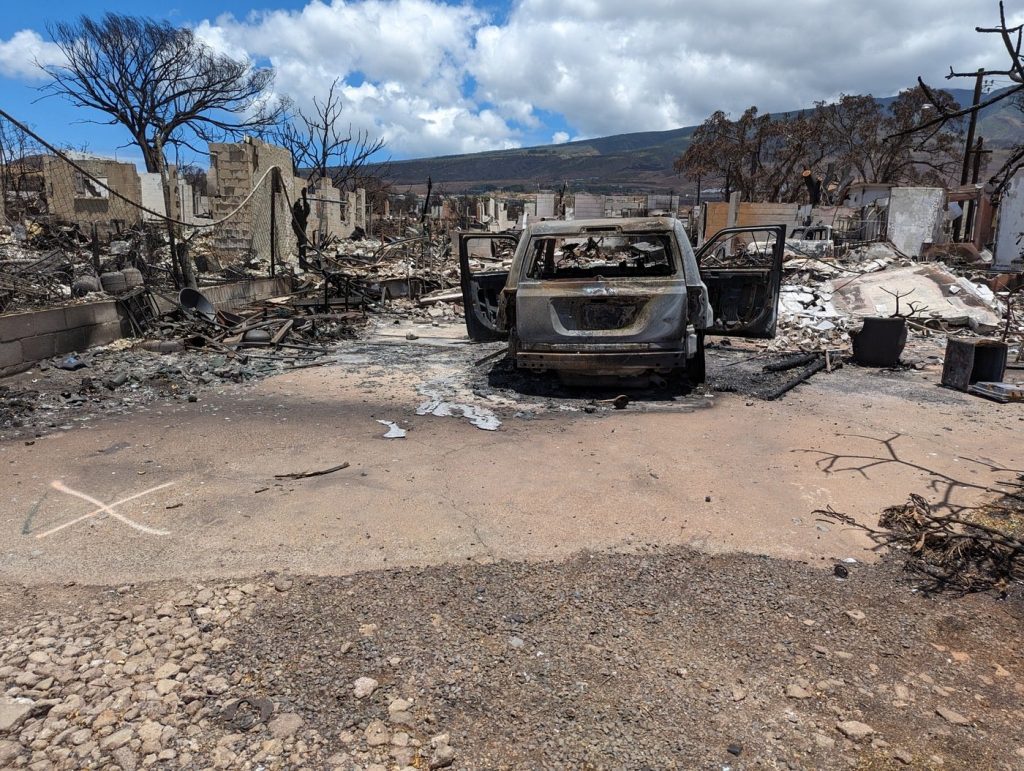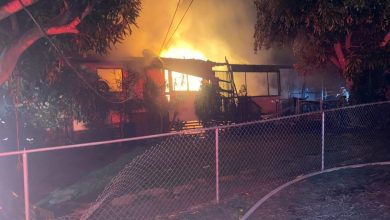Preliminary ash samples from Kula fire show high levels of toxic substances; same expected in Lahaina : Maui Now

[ad_1]
Preliminary, unvalidated data from ash sampling received late Friday night shows very high levels of arsenic, and elevated levels of lead and cobalt, in wildfire ash collected in Kula, the Hawaiʻi State Department of Health announced on Sunday.
The ash samples were collected on Sept. 21 in Kula from eight burned homes that had been constructed from the 1930s to the 2000s.
Ash samples have yet to be collected in the Lahaina burn area for testing. But because homes in the impacted area of Lahaina were constructed during the same time period, the Health Department expects that the ash in Lahaina will have a similar contaminant profile.

The Health Department will conduct testing of Lahaina ash when the US Environmental Protection Agency completes its removal of toxic and hazardous household fire debris, making it safe for employees to collect the samples, State Health Director Dr. Kenneth S. Frink said during a Sunday press conference.
In the ash samples, arsenic was found 140 times above the action level. Action level means a concentration of inorganic arsenic of 5 micrograms per cubic meter of air averaged over any eight hour period.
To put it more simply: Levels of arsenic in the ash were very high and pose a potential health risk to people with exposure to the ash. This finding reinforces the need to diligently follow recommendations to reduce potential exposure.
Arsenic is a heavy metal found in soils in Hawaiʻi due to volcanic soils and its use as an herbicide in the early 1900s. It is also found in building materials made of sugar cane (Canec) and wood treated for termite control (CCA treated wood).
Arsenic can also be found in food such as rice, meats, fish and seaweed and has also been found to be naturally occuring in well water around the world. Long-term, environmental exposure to arsenic can cause skin problems, heart problems and cancers of the skin, bladder and lungs.
Frink said cobalt was found in the ash samples at 20 times above the action level and lead was found at 3 times above the action level. These levels are considered elevated.
Lead is a heavy metal that is expected to be present in ash due its use in paint on houses built before 1978. Lead is particularly toxic for young children and babies in utero as it hinders the development of the brain.
Babies and children exposed to lead have trouble with learning, school performance, attention, and other neurocognitive problems. Lead levels in the ash were high and pose a health risk to children and pregnant women who are exposed to ash and dust from the burned areas.
Cobalt is a naturally occurring element that is essential for certain functions of the body including the generation of red blood cells. People are exposed to small amounts of cobalt in food, industrial air pollution and many cosmetics.
However, when people are exposed to excessive amounts of cobalt, it can cause problems with the blood, lungs and skin. Cobalt may also cause cancer with extreme exposures.
“While the presence of these substances is not unexpected, the concentration of arsenic in particular demonstrates the high toxicity of the ash and reinforces the importance of avoiding exposure to the ash,” Frink said. “It is important to remember that people can take action to minimize their exposure to these contaminants including avoiding disruption of ash and wearing proper PPE when in impacted areas.”
He also said people can limit exposure by keeping surfaces clean of dust and ash, and frequently washing hands.
| Parameter | Unit | Lab Report #1 | Lab Report #2 | Lab Report #3 | Mean Lab Reports | Soil Environmental Action Level |
| Arsenic | mg/kg | 3,240 | 3,260 | 3,080 | 3,193 | 23 |
| Lead | mg/kg | 86 | 81 | 89 | 85 | 4.7 |
| Cobalt | mg/kg | 640 | 769 | 655 | 688 | 200 |
Click here to view the preliminary, unvalidated ash sampling data.
The Department of Health is taking the following actions in Lahaina and Kula based on this preliminary data to protect public health:
- Requested Maui County and the EPA prioritize the application of Soiltac, a dust control agent and soil stabilizer, on impacted zones closest to inhabited areas. As arsenic is a metal that adheres to ash, preventing ash and dust from becoming airborne will greatly decrease the risk of exposure to arsenic and other contaminants. The EPA completed Soiltac application in Kula and areas near Lahaina schools.
- Recommends Maui County install higher dust screens around the impacted areas and use water misters in Lahaina to protect those residing next to the impact area to further control dust and ash from becoming airborne until Soiltac can be applied.
- Strongly recommends Maui County stop the use of sifters in areas next to inhabited areas during Lahaina re-entry visits because the sifters cause ash to become airborne.
- Will conduct additional air sampling in Lahaina and Kula for heavy metals, including arsenic. If ash or dust are not in the air at the time of sampling, it is unlikely that contaminants would be found in any measurable amount that would be considered harmful.
- Continue to install additional PM2.5 continuous air monitors. PM 2.5 is particulate matter that is 0.0025 millimeters and smaller in size (about 30 times smaller than a human hair) that can be a component of ash, dust, smoke and air pollution.
Lahaina and Kula residents are urged to take precautionary measures when in the impacted areas and avoid exposure to wildfire ash or dust.
All Lahaina and Kula residents can monitor real-time air quality at fire.airnow.gov or by downloading the AirNow mobile app. Additional apps such as Local Haze, IQAir, and Paku use the same data sources and allow for real-time alerts.
Contaminants of concern, such as metals like lead or arsenic, adhere to the pieces of ash and dust that register as PM 2.5. Because of this, air monitoring for PM 2.5 can be used as an indicator for contaminant monitoring.
If PM 2.5 measurements are not above typical baseline levels (remain in the green zone), then ash and dust from the impacted areas, with their associated contaminants, are very unlikely to be in the air in any measurable amount that would be considered harmful.
Air monitoring is indicative of the general air quality, and cleanup activities or other activities that disrupt the ash could cause hazardous dust and ash to become airborne in that highly localized area, creating a hazard.
If real-time air monitors in Lahaina or Kula are yellow, orange, red, or purple (AQI above 50):
- Avoid outdoor activities to reduce exposure and minimize health risks. This is particularly important for children and pregnant people.
- Stay indoors and close all windows and doors. If an air conditioner is used, set it to the recirculate option.
- If you need to leave the affected area, turn on your vehicle’s air conditioner and set it to the recirculate option.
Residents in areas near the impacted areas should take precautions such as daily mopping and wet wiping to keep household surfaces free of dust or ash. Children, who are most susceptible to the toxic effects of these chemicals, should not play outside in areas that contain ash.
DOH recommends people stay indoors and close windows when air quality indicator changes to any color other than green. Using one of the air quality mobile apps with alerts can be very helpful. If unable to access a mobile app, itʻs recommended to stay indoors and close windows if downwind of the impact area during a time of increased risk of disruption of the ash such as in high winds or zone re-opening.
Re-Entry Visits
The Department of Health urges individuals returning to impacted areas for temporary visits to follow re-entry guidance.
- Strongly recommends Maui County stop the use of sifters in areas next to inhabited areas because they cause ash to become airborne.
- Strongly recommends use of personal protective equipment when in impacted areas.
- Children and pregnant people absolutely should not enter impacted areas.
- Do not eat in impacted areas. Ensure that the spout or top of your water bottle is covered and protected from dust.
- Any objects removed from the impacted area must be immediately washed with soap and water.
- Strongly recommends people consider the risk of re-entry and thoughtfully decide if the risk of exposure to these contaminants is worth the benefit for them.
- Strongly recommends people limit their time in the re-entry zone as much as possible.
Schools
The Health Department has been working with the State Department of Education, Maui County and other partners to assess risk at West Maui schools.
“The Department of Education continues to strongly believe that reopening our Lahaina schools for in-person learning is critical for the well-being of our students and the community,” Keith Hayashi, superintendent of the Department of Education, said during a press conference.
“We have been reassured that our campuses are safe for students and staff to be at based on current air quality conditions and the extensive environmental testing we’ve done over the last several week.”
With this new data showing high levels of toxins in the ash, school safety guidelines have been revised to “be extra cautious if the air monitors pick up particles in the air,” Hayashi said.
Plans remain unchanged to reopen Lahaina schools, beginning on Monday with Lahainaluna High School.
“We understand families will need to take in this new information, process what it means, and make decisions that are best for their situation and their ‘ohana,” Hayashi said. “Our schools will be flexible on student absences during this first week of reopening as families make decisions.”
Soiltac was applied to impacted areas near Lahaina schools. This adds an additional layer of protection to keep dust and ash from becoming airborne.
If real-time air monitors indicate AQI over 50, the Health Department recommends that the Department of Education follow its updated guidance to limit outdoor activities and assess if further action needs to be taken.
The Health Department and the EPA have installed real-time air monitors at West Maui schools and between the schools and the impacted area. The Department of Education has assigned staff to monitor air quality at Lahaina schools.
Extensive environmental testing already conducted at the schools by the two state agencies has not shown evidence of any transportation of ash or these contaminants from the impacted areas.
Soil testing from all three Lahaina schools did not show levels of arsenic or lead beyond background levels and wipe samples of school surfaces did not detect lead or arsenic.
The Department of Education will continue to do bi-weekly wipe sampling on indoor and outdoor surfaces at the schools to monitor for any transport of these contaminants from the impacted areas.
It is important to note that the data available has not yet been validated and final results may vary. This means the currently available data is preliminary and has not been double checked by the lab or quality tested by an independent third party. The final testing results may be different. That validation process is ongoing and may take several weeks; the validated results will be shared as soon as they are available.
Organochlorine pesticides used historically in Hawaiʻi such as chlordane, DDT, dieldrin, heptachlor and related chemicals were not detected in the ash.
The Health Department said it will continue to analyze the results to assess any potential risks from other contaminants such as polycyclic aromatic hydrocarbons (PAHs), Dioxins and others.
[ad_2]
Source: Maui News




